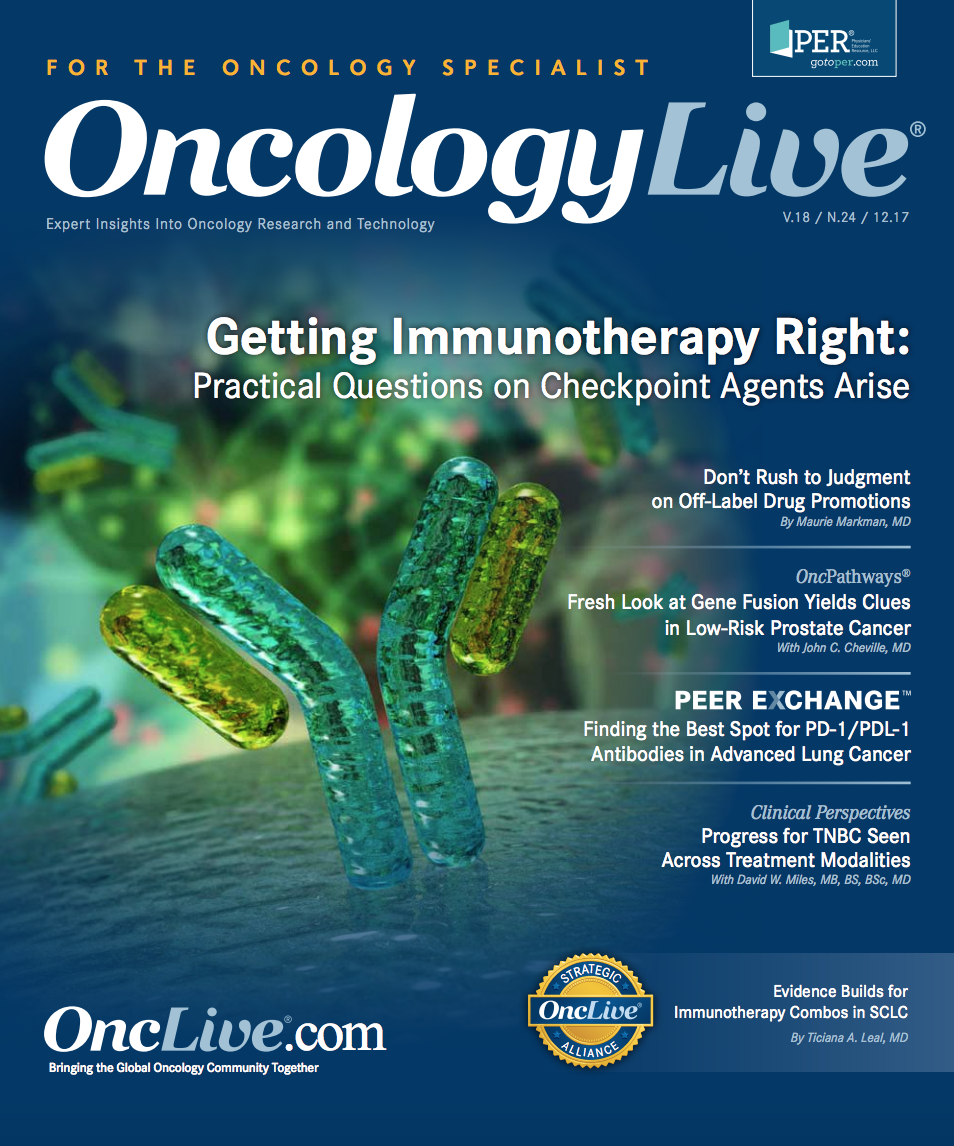Publication
Article
Oncolytic Virus Therapy Passes Early Efficacy Tests in Glioma Subtypes
Author(s):
A2-step oncolytic virus has demonstrated promising signals against aggressive forms of brain cancers, including recurrent glioblastoma multiforme and anaplastic astrocytoma, in early clinical studies.
Clark C. Chen, MD, PhD

Clark C. Chen, MD, PhD
A2-step oncolytic virus has demonstrated promising signals against aggressive forms of brain cancers, including recurrent glioblastoma multiforme (GBM) and anaplastic astrocytoma (AA), in early clinical studies, according to findings presented at the 2017 AACRNCI-EORTC International Conference on Molecular Targets and Cancer Therapeutics.
Toca 511 (vocimagene amiretrorepvec) and Toca FC (extended-release 5- fluorocytosine [5-FC]) induced durable responses in patients with GBM and AA, with a median duration of response of 35.1+ months, said Clark C. Chen, MD, PhD, in a presentation during the conference, held in October in Philadelphia. In a pooled analysis of 3 phase I studies, the virus also proved to be well tolerated, with fewer any-grade adverse events (AEs) than with standard chemotherapy.1
Toca 511 is a replicating nonlytic retrovirus that encodes the cytosine deaminase (CD) protein and can turn 5-FC into 5-fluouracil (5-FU), which activates the immune system against cancer, explained Clark C. Chen, who is the Lyle French Chair in Neurosurgery and department head of neurosurgery at the University of Minnesota in Minneapolis. The virus is injected into the site of highest tumor concentration in the brain by a surgeon. Later, Toca FC, a novel formulation of an antifungal drug, 5-FC, is given to the patient orally, and the CD gene converts the 5-FC into 5-FU.
The virus has selective ability to replicate in cancer cells because it affects only dividing cells and because 5-FC is benign in normal cells, said Chen. Additionally, the virus can replicate and spread and has the ability to track the tumors. In preclinical studies, Chen noted that the investigators saw not only tumor cell death but also the depletion of immunosuppressive cells, which led to significant T-cell infiltration.2
Early Clinical Findings
“This approach is fundamentally not just a gene therapy but also an immune therapy that combines the efficacy of both approaches,” said Chen.Three phase I studies were conducted to test the safety and tolerability of Toca 511 and Toca FC in 127 total patients with recurrent high-grade gliomas.1 The first dose-escalating study looked at 56 patients who had undergone surgical resection of their brain tumor (NCT01470794), and Chen focused on safety and efficacy results from this study in his presentation. In the second study, the tumor was infused into 54 patients with unresectable tumors (NCT01156584), and the third focused on neoadjuvant intravenous administration of the virus in patients with grade III/IV glioma (NCT01985256).
In the resectable trial, patients were eligible if they had a good performance status, had never received bevacizumab (Avastin), and if their tumor was ≤5 cm. All patients underwent surgery before receiving injection of Toca 511 once at a dose between 1.4 x 107 and 4.8 x 109 TU, followed approximately 6 weeks later by administration of cyclic Toca FC from 135 to 220 mg/kg/day. A majority of the patients (77%) were male, 70% had a Karnofsky performance status of 90 to 100, 82% had GBM, and 11% had AA. Half of the patients were at their first recurrence at baseline, but 27% had had at least 3 recurrences.
Of 53 evaluable patients, 11.3% achieved a durable response rate lasting ≥24 weeks, all of which were complete responses (CRs), and an additional 18.9% had stable disease. Responses were observed in 4 patients with IDH1 wild-type GBM and in 2 patients with IDH1-mutant AA.
Twenty-three patients were included in a higherdose subgroup who met the criteria for the phase II/ III study. These patients were in their first or second recurrence, had recurrent GBM or AA, had no prior bevacizumab therapy, and had a tumor size ≤5 cm. In this subgroup, 21.7% achieved a CR lasting ≥24 weeks, and 21.7% had stable disease. The median duration of response was 35.7+ months. The responses occurred in 3 patients with IDH1 wild-type GBM and 2 patients with IDH1-mutant AA. Chen noted that they did not believe that IDH mutation status affected responses.
“Responses occurred gradually over a 6- to 19-month period. We actually saw patients who went from partial response to a total response late in treatment,” Chen said.
The median overall survival (OS) in the higherdose subgroup was 14.4 months, which compared favorably with historical controls of a median OS of 8.4 months seen with lomustine (Gleostine) for GBM. The 1-year OS in the overall study was 49.1% and 65.2% in the higher-dose subgroup. At 2 years, the OS was 24.5% overall and 34.8% in the subgroup, and at 3 years the OS rates were 13.4% and 26.1%, respectively.
Long-term survivors tended to have lowergrade tumors in the Toca 511 and Toca FC study, Chen noted. He also added that an immune abscopal effect was also seen whereby distant tumors that were not injected with the virus also responded to therapy.
Across the 3 studies, 25.2% of patients had grade 1/2 treatment-related AEs, most frequently fatigue (11%), and grade ≥3 events were seen in 7.1%. Seven (5.5%) serious AEs of grade ≥3 were observed, including grade 3 brain edema, grade 4 subdural hygroma, grade 3 asthenia with grade 2 pyrexia (with unrelated pulmonary embolism), grade 1 convulsion, grade 3 cerebral cyst, and 2 cases of grade 3 vasogenic cerebral edema. No deaths occurred that were related to the virus, Chen noted.
Notably, no hematologic toxicity was noted with the virus in patients with GBM, whereas standard-of-care lomustine often showed high rates of hematologic AEs.
Toca 511 and Toca FC received a breakthrough therapy designation from the FDA in February 2017 for treatment of patients with recurrent high-grade glioma. The FDA also granted a Fast Track designation to the virus in July 2015.
The Toca 5 trial is a multicenter, randomized, open-label phase II/III trial that is looking at Toca 511 and Toca 5C compared with investigator’s choice of lomustine, temozolomide, or bevacizumab in patients with GBM or AA who are undergoing resection following their first or second recurrence (NCT02414165). The trial recently started to enroll patients.
References
- Cloughesy TF, Landolfi J, Vogelbaum M, et al. Durable responses observed in recurrent high-grade glioma (rHGG) with Toca 511 and Toca FC treatment. Presented at: 2017 AACR-NCI-EORTC International Conference on Molecular Targets and Cancer Therapeutics; October 26-30, 2017; Philadelphia, PA. Abstract A085. abstractsonline.com/ pp8/#!/4557/presentation/619.
- Mitchell LA, Lopez Espinoza F, Mendoza D, et al. Toca 511 gene transfer and treatment with the prodrug, 5-fluorocytosine, promotes durable antitumor immunity in a mouse glioma model. Neuro Oncol. 2017;19(7):930-939. doi: 10.1093/neuonc/nox037.









